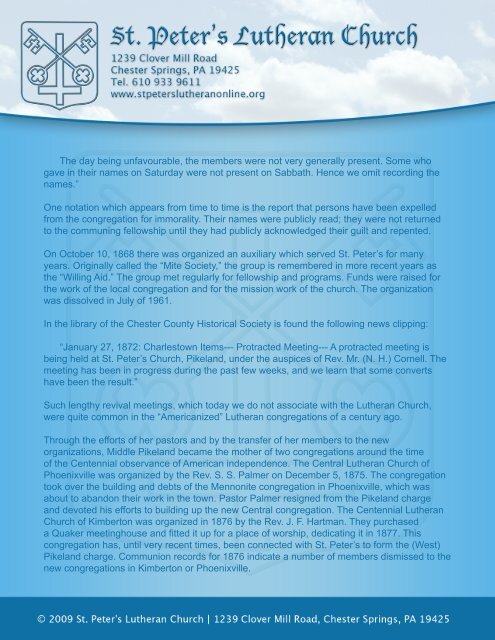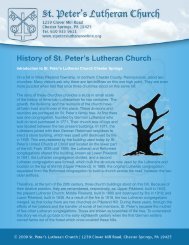History of St. Peter's Lutheran Church
History of St. Peter's Lutheran Church
History of St. Peter's Lutheran Church
You also want an ePaper? Increase the reach of your titles
YUMPU automatically turns print PDFs into web optimized ePapers that Google loves.
The day being unfavourable, the members were not very generally present. Some who<br />
gave in their names on Saturday were not present on Sabbath. Hence we omit recording the<br />
names.”<br />
One notation which appears from time to time is the report that persons have been expelled<br />
from the congregation for immorality. Their names were publicly read; they were not returned<br />
to the communing fellowship until they had publicly acknowledged their guilt and repented.<br />
On October 10, 1868 there was organized an auxiliary which served <strong>St</strong>. Peter’s for many<br />
years. Originally called the “Mite Society,” the group is remembered in more recent years as<br />
the “Willing Aid.” The group met regularly for fellowship and programs. Funds were raised for<br />
the work <strong>of</strong> the local congregation and for the mission work <strong>of</strong> the church. The organization<br />
was dissolved in July <strong>of</strong> 1961.<br />
In the library <strong>of</strong> the Chester County Historical Society is found the following news clipping:<br />
“January 27, 1872: Charlestown Items--- Protracted Meeting--- A protracted meeting is<br />
being held at <strong>St</strong>. Peter’s <strong>Church</strong>, Pikeland, under the auspices <strong>of</strong> Rev. Mr. (N. H.) Cornell. The<br />
meeting has been in progress during the past few weeks, and we learn that some converts<br />
have been the result.”<br />
Such lengthy revival meetings, which today we do not associate with the <strong>Lutheran</strong> <strong>Church</strong>,<br />
were quite common in the “Americanized” <strong>Lutheran</strong> congregations <strong>of</strong> a century ago.<br />
Through the efforts <strong>of</strong> her pastors and by the transfer <strong>of</strong> her members to the new<br />
organizations, Middle Pikeland became the mother <strong>of</strong> two congregations around the time<br />
<strong>of</strong> the Centennial observance <strong>of</strong> American independence. The Central <strong>Lutheran</strong> <strong>Church</strong> <strong>of</strong><br />
Phoenixville was organized by the Rev. S. S. Palmer on December 5, 1875. The congregation<br />
took over the building and debts <strong>of</strong> the Mennonite congregation in Phoenixville, which was<br />
about to abandon their work in the town. Pastor Palmer resigned from the Pikeland charge<br />
and devoted his efforts to building up the new Central congregation. The Centennial <strong>Lutheran</strong><br />
<strong>Church</strong> <strong>of</strong> Kimberton was organized in 1876 by the Rev. J. F. Hartman. They purchased<br />
a Quaker meetinghouse and fitted it up for a place <strong>of</strong> worship, dedicating it in 1877. This<br />
congregation has, until very recent times, been connected with <strong>St</strong>. Peter’s to form the (West)<br />
Pikeland charge. Communion records for 1876 indicate a number <strong>of</strong> members dismissed to the<br />
new congregations in Kimberton or Phoenixville.




